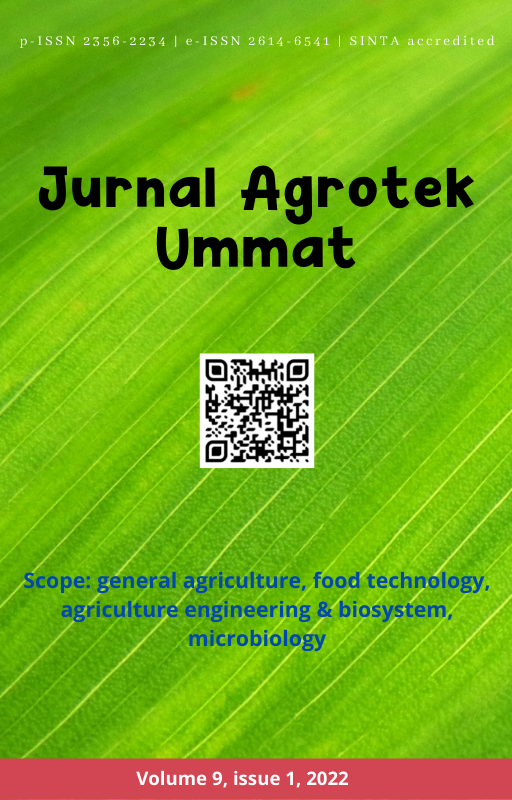Own pick orange agrotourism development strategy in the Merek District of Karo Regency
DOI:
https://doi.org/10.31764/jau.v9i1.7300Keywords:
agrotourism, development, oranges self-picking, strategyAbstract
Agrotourism is a series of tourism activities that develop agricultural activities as the main target of tourism. Agritourism covers various aspects of agriculture, including natural landscapes, agricultural activities, diversity in agricultural production, agricultural technology, and agricultural customs prevailing. The research purpose was to analyze and identify internal and external factors and develop appropriate strategies for orange self-picking agrotourism. The research was carried out in orange self-picked agrotourism in Merek District, Karo Regency, North Sumatra Province purposively. The research sample was 40 samples. Data analysis was carried out using the IFE (Internal Factor Evaluation), EFE (External Factor Evaluation) matrix, SWOT matrix, and AHP (Analytical Hierarchy Processes). The research results determined the 12 internal factors and 12 external factors. In addition, there were 13 strategies for developing the orange self-picking agrotourism.
References
Chadda, D., & Bhakare, S. (2012). Socio-Economic Implications Of Agri Tourism in India. International Conference on Innovation, Trade and Economics-ICITE, 30, 151–155.
David, F. R. (2010). Manajemen Strategi :Konsep dan Kasus, Edisi ke 12. Jakarta : Salemba Empat.
Endarto, O., & Martini, E. (2016). Pedoman Budidaya Jeruk Sehat. Balai Penelitian Tanaman Jeruk Dan Buah Subtropika (Balitjestro) Bekerjasama Dengan Agfor Sulawesi. Bogor : World Agroforestry Centre (ICRAF) Southeast Asia Regional Program.
Feili R, Zaman W, Abdullah WNW, Yang, & Tajul A. (2017). Physical and Sensory Analysis of High Fiber Bread Incorporated With Jackfruit Rind Flour. Food Sci Technol, 1, 30–36.
Gal Y, Gal, A., & Hadas, D. (2010). Coupling Tourism Development and Agricultural Processes in a Dynamic Environment. Current Issues in Tourism, 13, 279–295.
Gurindawangsa, S. A., Topowijono, & Supriono. (2017). Analisis Startegi Pengembangan Produk Agrowisata. Jurnal Administrasi Publik, 51(2), 141–150.
Hutama, A. W., & Purnomo, H. (2016). Wisata Agrikultur Modern Kota Gresik. Jurnal Sains Dan Seni ITS, Vol 5(No 2), hal 151–154.
Kartika, E. (2017). Strategi Pengembangan Objek Wisata Air Terjun Sipiso-piso Dan Tongging Dalam Rangka Pembangunan Pariwisata Danau Toba. Universitas Sumatera Utara.
Kurniasanti, S. A. (2019). Analisis Strategi Pengembangan Produk Agrowisata. Journal of Tourism and Creativity, 3(1), 65–76.
Malkanthi, S., & Routry, J. (2011). Potential for Agritourism Development: Evidence from Sri Lanka. Journal of Agricultural Sciences, 6(1), 45–58.
Manzoor, F., Wei, L., Asif, M., Haq, M. Z. ul, & Rehman, H. ur. (2019). The Contribution of Sustainable Tourism to Economic Growth and Employment in Pakistan. International Journal of Environmental Research and Public Health, 16(19).
Palit. (2017). Tujuan Agrowisata Untuk Memperluas Pengetahuan. Jakarta. Gramedia.
Satya, V. E. (2018). Strategi Indonesia Menghadapi Industri 4.0. Info Singkat, 10(9), 19–24.
Siahaan, S. (2019). Kebun Madu Efi, Wisata Edukasi Kekinian di Tanah Karo. Tribun-Medan.com.
Tompodung, A. S., Poluan, R. ., & Rate, J. Van. (2017). Pengembangan Kawasan Agrowisata Di Kecamatan Tomohon Timur. 4(1), 125–135.
Utama, I. G. B. R. (2011). Agrowisata Sebagai Pariwisata Alternatif Indonesia. Yogyakarta : Deepublish.
Wilantara, R. F., & Susilawati. (2016). Strategi Dan Kebijakan Pengembangan UMKM. Bandung : Refika Aditama.
Yang Z, Cai, J., & Sliuzas, R. (2010). Agro-tourism enterprises as a form of multifunctional urban agriculture for peri-urban development in China. Habitat International, 34, 374–385.
Yang Z, Yang L, Xiao-Yan, Q., & Yu-me, S. (2009). Municipal Solid Waste Management in Beijing City. Waste Management, 29(9).
Yang, Z. (2012). Analysis on Cloud Computing Security Threat. Communications Technology, 9.
Downloads
Published
Issue
Section
License
Authors who publish articles in Jurnal Agrotek Ummatagree to the following terms:- Authors retain copyright of the article and grant the journal right of first publication with the work simultaneously licensed under a CC-BY-SA or The Creative Commons Attribution–ShareAlike License.
- Authors are able to enter into separate, additional contractual arrangements for the non-exclusive distribution of the journal's published version of the work (e.g., post it to an institutional repository or publish it in a book), with an acknowledgment of its initial publication in this journal.
- Authors are permitted and encouraged to post their work online (e.g., in institutional repositories or on their website) prior to and during the submission process, as it can lead to productive exchanges, as well as earlier and greater citation of published work (See The Effect of Open Access).

